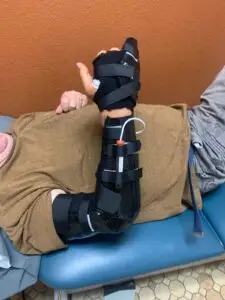Hand Splints
A custom- made hand splint offers personalized support, designed to fit the individual's specific injury or conditions. It helps reduce pain, improve alignment, and promote healing while enhancing function and comfort.


Hand splints are devices used to support, protect, or immobilize the hand, wrist, fingers, or thumb. They can be made of various materials like plastic, metal, or fabric with Velcro straps, and are commonly used in medical and therapeutic settings.
Immobilization: To prevent movement after injury or surgery (e.g., fractures, tendon repairs).
Support: To stabilize weak or painful joints (e.g., arthritis, carpal tunnel syndrome).
Correction: To improve or prevent deformities (e.g., after stroke or with cerebral palsy).
Functional aid: To help with daily activities by improving grip or hand positioning.
Resting splints – Hold the hand in a neutral position during rest or sleep.
Wrist cock-up splints – Keep the wrist in a straight or slightly extended position, often used for carpal tunnel syndrome.
Thumb Spica splints – Immobilize the thumb and wrist, helpful in treating thumb injuries or arthritis.
Ulnar or radial gutter splints – Immobilize specific fingers or the side of the hand after fractures.
Dynamic splints – Use springs or elastic bands to assist movement or stretch tight muscles/tendons over time.
To see a PDF of the different types of splint we’ve made, click here: OPT Splint Handout
Custom made Hand Splints can be beneficial for a wide range of conditions, including but not limited to:
Orthopedic & Musculoskeletal Conditions
Fractures – fingers, metacarpals, wrist
Tendon injuries or repairs – e.g., flexor/extensor tendon injuries
Ligament sprains/tears – e.g., skier’s thumb (UCL injury)
Joint dislocations
De Quervain’s Tenosynovitis – inflammation of tendons near the thumb
Trigger finger – locking or catching of a finger in a bent position
Tendonitis/Tenosynovitis – inflammation of tendons or sheaths
Inflammatory & Degenerative Conditions
Rheumatoid arthritis – splints reduce joint pain, deformity, and inflammation
Osteoarthritis – especially of the thumb (CMC joint)
Carpal tunnel syndrome – wrist splints relieve nerve compression
Neurological Conditions
Other Conditions
Complex Regional Pain Syndrome (CRPS) – reduce pain and protect the hand
Congenital hand deformities – splinting for early correction or support
A custom made hand splint appointment begins with a thorough assessment of your condition including a physical examination and discussion of your therapy goals. Based on the assessment, your personalized treatment plan will be developed, outlining the specific splint needed. The exercises assigned are designed to improve strength, flexibility, and coordination. This may include stretching, strengthening exercises, and fine motor activities.
Hand splints are versatile tools that support healing, reduce pain, prevent deformity, and improve function in conditions affecting bones, muscles, tendons, nerves, or joints.
Hand splints play a vital role in reducing pain, promoting healing, enhancing function, and preventing long-term complications. When custom-made by occupational or physical therapists, they can be tailored precisely to the individual’s needs for maximum benefit. If you or someone you know is experiencing hand-related issues, contact Optimal Therapy 702-564-6712 for a successful recovery.
If you want to skip the wait, you can reach our scheduling team Monday through Friday from 9am – 5pm.